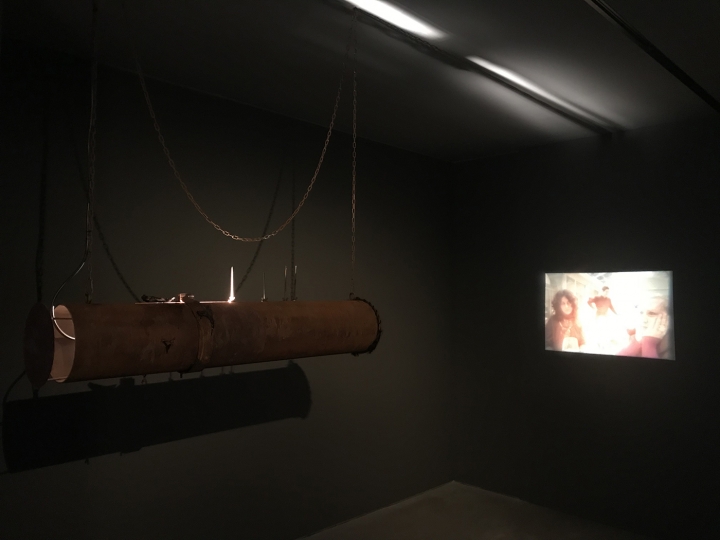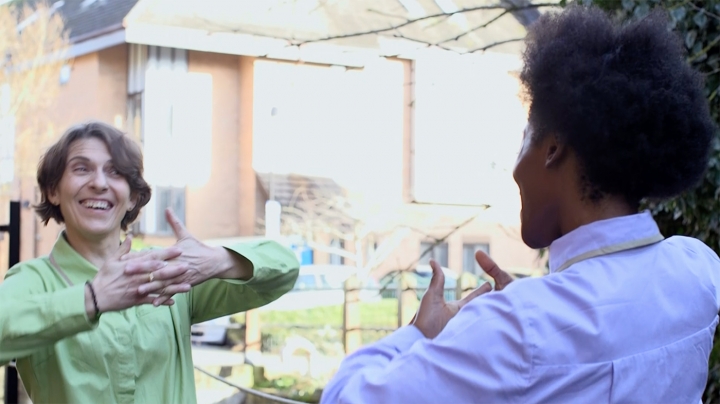*This review is published in Hyperallergic: https://hyperallergic.com/447649/galeri-nev-istanbul-we-do-not-know-this-to-be-so/
Joanna Rajkowska, “The Peterborough Child” (2012), video, 30 min. (image courtesy of the artist)
Making sense of death is a cultural mainstay, regardless of class or nationality, religion or race, gender or sexuality; most of us spend periods of time thinking about mourning, whether from inside or outside the process. But how it is done, approached, and thought about, varies pretty dramatically. The current exhibition on view at Galeri Nev Istanbul presents five artists, all from different places, each contending with how we mourn. Curator Pelin Uran’s emphasis on video work speaks to the issue’s ubiquitous nature and fuels tension among the different ways of externalizing grief.
The gallery is small, and you immediately walk into Alejandro Cesarco’s video work “Present Memory” (2009). Projected on the wall is an image of Cesarco’s father, taken just after he was diagnosed with cancer. Upon death, this footage of the father is projected into his empty study, and recording it again, creating an infinite space where different segments of time intersect. The image is strained, threadbare, so worn-out that it creates the feeling that we are following a ghost in a dream-like state. The fact that his father looks directly at the camera in a highly serious manner makes the audience feel that we are disturbing him, and have been brought here to help the artist to release his father’s ghost.
Barbad Golshiri, “Vanitas; a Reenactment” (2008-2014), metal construction, light, slide, and liver, 22 x 120 cm (image courtesy of the artist)
There are other moments in the show that reflect on the difficulty of dealing with loss. As in the case of Cesarco, who breaks the linearity of time to heal, the devastating characteristic of death echoes in a work by Barbad Golshiri, titled “Vanitas; a Reenactment” (2008–14). As a response to Italian collector, Claudia Gian Ferrari’s final days, Golshiri builds a metal cylindrical projector. The odd thing about the work is a piece of animal liver being cooked by the projector lamp and dripping blood onto the floor. These drops reference a Persian literary trope, tears. An image of the gallerist Ferrari lights the wall. She is distinguished by a snake-shaped ring and red hair, both recalling symbols of death. It is definitely not a work for everyone, for the ways it evokes extremely disturbing that feel uncomfortably personal.
Oreet Ashery, “Revisiting Genesis – Episode 9: Our Nurses” (2016), web series video, 11 minutes (image courtesy of the artist)
The show creates confusing feelings of devastation and lightness, genesis and destruction, as death usually does. Acting as a debriefing session for these feelings, the rest of the works in the show suggest the importance of community support when dealing with grief, particularly so in Oreet Ashery’s video “Our Nurses” (2016). The work brings together four palliative nurses, who develop close relationships with their patients, and experience grief every day. Put together, the four talk about emotional burn-out, making me think about Joan Didion’s “The Year of Magical Thinking” in which she mentions that grief is like an illness with all the physical symptoms, and we need to talk about it to heal. You can feel the relief of these nurses through their movement. They dance in pairs, interrupting the work’s main narrative, as they mimic each other and laugh, randomly moving their hands, hips, and feet.
The neighboring video by Joanna Rajkowska “The Peterborough Child” (2012) shows another artist desperately searching for a platform to talk about her fear of loss. After her daughter was diagnosed with eye cancer, and inspired by the ruins of Peterborough, where she had just moved to, the artist works to build a fake archeological site, containing a hand-made skeleton of a baby girl. The video tells the story of this project using a male voice, creating a video collage of found and shot images. Although Rajkowska is hoping that this place would turn into a temple for mothers in this city, a place that suffers an extremely high infant mortality rate, the project was cancelled due to protests from the community. This work highlights the fact that it is not always easy to find community support for new grieving methods.
The Propeller Group, “The Living Need Light, The Dead Need Music” (2014), single channel projection, 21.15 mins. (image courtesy of The Propeller Group and James Cohan, New York)
Presented in a separate room, The Propeller Group’s video titled “The Living Need Light, The Dead Need Music” (2014) showcases the benefits of community support. Separated from the other works in the show, this work creates an immersive experience for the audience to become part of the festivity of funeral traditions in Vietnam. As a musical journey, it merges documentary footage of funerals with re-enactments, creating a poetic language. The work develops around a transgender character and visualizes her passage from life to death. With performers hired for the funerals — fire eaters, snake handlers, singers — it makes a meaningful closing for the show, highlighting that death is not only loss, but provides an opportunity to celebrate life.
We do not know this to be so is on view at Galerie Nev Istanbul (Mumhane Caddesi No: 46- 50 Kat 2, Karaköy İstanbul) through June 22.



